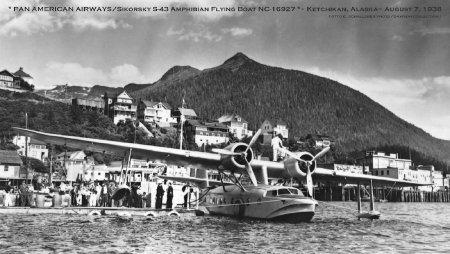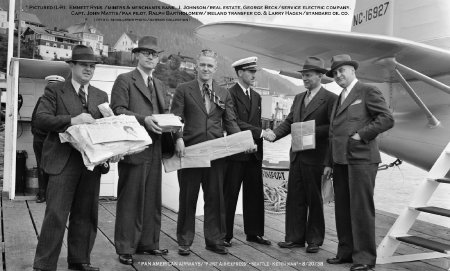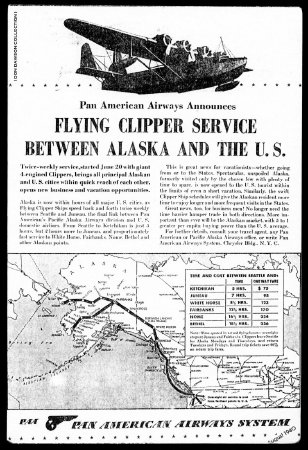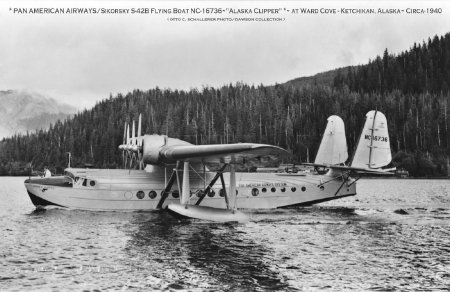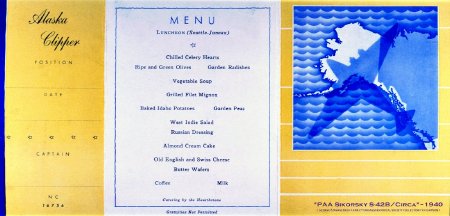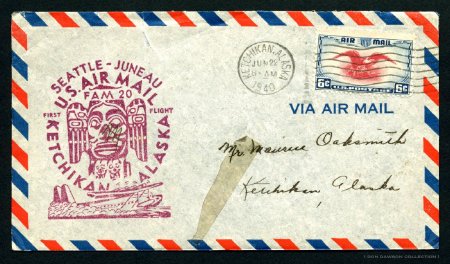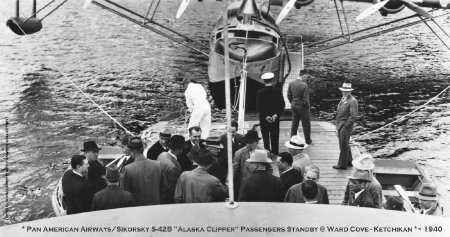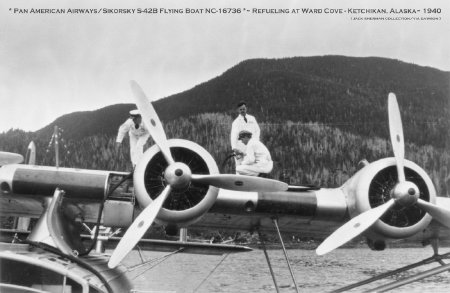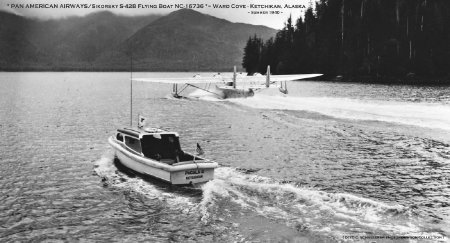Description:
Pan American Airways, 1940
Toward the end of the 1930s, Pan American Airways was enjoying tremendous success with its growing international service via the use of large clipper flying boats with incredible range and substantial speed and payload carrying ability. They figured these clippers might just be the answer to their expansion challenges for offering flights into Southeast Alaska cities from the Contiguous U.S. In 1938, after filing for their route certificate for operations into the region, Pan American Airways initiated a series of route survey flights from Seattle to Juneau with intermediate stops in Ketchikan.
Their original plan had been to use 4-engine landplanes on this route, but airport development was lagging way behind schedule. The Panhandle's sole airport was the one Pan American Airways constructed at Juneau in 1935. On August 7, 1938, the first Pan American clipper flying boat arrived in downtown Ketchikan at City Float, making its maiden proving flight employing a twin-engine Sikorsky S-43 amphibian (NC16927), with captains John Mattis and Joe Crosson at the controls. The "Baby Clipper", as locals liked to call it, began a weekly series of survey flights that ran into 1939. After the initial flight, Captain S. E. Robbins replaced Crosson as the regular assigned second pilot. While no ticketed passengers were allowed to be carried aboard during survey flights, Air-Express package and official U.S. Mail delivery service was introduced on August 20, 1938. Both the single-tail and twin-tailed S-43 amphibians were used to conduct the 1938-1939 route survey flights. With an 86 ft. wingspan, they were the largest commercial plane to fly into Ketchikan at that point in time. The S-43's 140 mph cruising speed made the 650-mile Seattle-Ketchikan trip in 6 hours and 39 minutes.
As anticipated, the region's frequently adverse climate played havoc with attempts at simulating concise and reliable flight schedules. Nonetheless, Pan American Airways was granted approval of its certificate. In 1940, the airline began running twice-weekly Seattle-Ketchikan-Juneau scheduled passenger flights, this time using the larger 4-engine Sikorsky S-42B "Alaska Clipper" flying boat (NC16736). The 19-ton seaplane boasted a massive 114 ft. wingspan and was 69 ft. long. It was powered by four 700 hp radial engines. Its initial shakedown flight arrived in Ketchikan on June 14, 1940 at 3:25 p.m. with the clipper mooring north of town at Ward Cove due to its huge size. Pilot S. E. Robbins and co-pilot Joe Crosson were at the controls with a crew of ten accompanied by three Civil Aviation Authority inspectors, a U.S. Weather Bureau representative, and military observers for the U.S. Army, Navy, and Coast Guard. The plane departed an hour and a half later bound for Juneau.
Ellis Air Transport's Don Wright served as Pan American Airways' Ketchikan agent, with Jack Sherman as Pan American Airway's designated local maintenance chief. The first official S-42 passenger flight arrived in Ketchikan at 5:00 p.m. on June 20, 1940, piloted by S. E. Robbins and carrying 25 passengers (complimentary non-revenue), plus 165 lbs. of freight, that was mostly 15,000-20,000 1st Official Flight Cover cache letter envelopes. Due to its late arrival due to strong headwinds, the clipper overnighted before continuing on the next day. Captain Jerry Jones took over for the return leg back to Seattle. The first scheduled revenue flight departed Seattle on Monday, June 24, 1940 at 10:40 a.m. carrying 20 passengers who paid $75 per ticket for the 5-hour flight to Ketchikan. Travelers enjoyed seaplane flying in regal first class comfort, complete with inflight dining services that offered a full menu, while commuting from the contiguous U.S. to Ketchikan and onward up to Juneau.
It's important to note that at this stage of the game, much to the shock of Panhandle residents, Pan American Airways announced a stipulation made by the Civil Aviation Authority in granting permission to run scheduled flights into Southeast Alaska via the coastal route. Both passengers and mail on the new runs could not be shuttled between Ketchikan and Juneau, so as not to conflict with grandfather rights of local air carriers. The traffic had to be ticketed from Seattle direct to either Ketchikan or Juneau and vice-versa on the return flight. Both Alaska Air Transport and Marine Airways in Juneau were adamant on this, though their flights were being made strictly on a charter basis. The Ketchikan carriers didn't really object to the Pan American Airways clipper runs, but ended up backing their Juneau counterparts. As a direct-result, Alaska Air Transport, Marine Airways, and Aircraft Charter Service initiated scheduled runs between the two cities to coincide with the beginning of the regular Pan American Airways runs in 1940. This was to placate the many disgruntled citizens who had hoped to commute in comfort via Pan American Airways' fast, modern, 32 passenger seaplanes, and clipper travelers wanting to over-stay on their trips.
As experienced during the route survey flights, Alaska's fickle fall weather again showed that Mother Nature dictated the unpredictable and disrupted any chance of running regular scheduled flights. The final S-42 flight was the November 8, 1940 return to Seattle, after overnighting in Ketchikan, carrying only 12 passengers. Pan American Airways then commenced mail only flights along the mainland route to Juneau using Douglas DC-3s and Lockheed Lodestars. Passenger service started in March 1941. This route ran from Seattle via Prince George, B. C. to Juneau, Whitehorse, and Fairbanks. Pan American Airways DC-3s and Lodestars resumed periodic service for passengers to Ketchikan during WWII after the military constructed the nearby Annette Island Army Air Field.
Their original plan had been to use 4-engine landplanes on this route, but airport development was lagging way behind schedule. The Panhandle's sole airport was the one Pan American Airways constructed at Juneau in 1935. On August 7, 1938, the first Pan American clipper flying boat arrived in downtown Ketchikan at City Float, making its maiden proving flight employing a twin-engine Sikorsky S-43 amphibian (NC16927), with captains John Mattis and Joe Crosson at the controls. The "Baby Clipper", as locals liked to call it, began a weekly series of survey flights that ran into 1939. After the initial flight, Captain S. E. Robbins replaced Crosson as the regular assigned second pilot. While no ticketed passengers were allowed to be carried aboard during survey flights, Air-Express package and official U.S. Mail delivery service was introduced on August 20, 1938. Both the single-tail and twin-tailed S-43 amphibians were used to conduct the 1938-1939 route survey flights. With an 86 ft. wingspan, they were the largest commercial plane to fly into Ketchikan at that point in time. The S-43's 140 mph cruising speed made the 650-mile Seattle-Ketchikan trip in 6 hours and 39 minutes.
As anticipated, the region's frequently adverse climate played havoc with attempts at simulating concise and reliable flight schedules. Nonetheless, Pan American Airways was granted approval of its certificate. In 1940, the airline began running twice-weekly Seattle-Ketchikan-Juneau scheduled passenger flights, this time using the larger 4-engine Sikorsky S-42B "Alaska Clipper" flying boat (NC16736). The 19-ton seaplane boasted a massive 114 ft. wingspan and was 69 ft. long. It was powered by four 700 hp radial engines. Its initial shakedown flight arrived in Ketchikan on June 14, 1940 at 3:25 p.m. with the clipper mooring north of town at Ward Cove due to its huge size. Pilot S. E. Robbins and co-pilot Joe Crosson were at the controls with a crew of ten accompanied by three Civil Aviation Authority inspectors, a U.S. Weather Bureau representative, and military observers for the U.S. Army, Navy, and Coast Guard. The plane departed an hour and a half later bound for Juneau.
Ellis Air Transport's Don Wright served as Pan American Airways' Ketchikan agent, with Jack Sherman as Pan American Airway's designated local maintenance chief. The first official S-42 passenger flight arrived in Ketchikan at 5:00 p.m. on June 20, 1940, piloted by S. E. Robbins and carrying 25 passengers (complimentary non-revenue), plus 165 lbs. of freight, that was mostly 15,000-20,000 1st Official Flight Cover cache letter envelopes. Due to its late arrival due to strong headwinds, the clipper overnighted before continuing on the next day. Captain Jerry Jones took over for the return leg back to Seattle. The first scheduled revenue flight departed Seattle on Monday, June 24, 1940 at 10:40 a.m. carrying 20 passengers who paid $75 per ticket for the 5-hour flight to Ketchikan. Travelers enjoyed seaplane flying in regal first class comfort, complete with inflight dining services that offered a full menu, while commuting from the contiguous U.S. to Ketchikan and onward up to Juneau.
It's important to note that at this stage of the game, much to the shock of Panhandle residents, Pan American Airways announced a stipulation made by the Civil Aviation Authority in granting permission to run scheduled flights into Southeast Alaska via the coastal route. Both passengers and mail on the new runs could not be shuttled between Ketchikan and Juneau, so as not to conflict with grandfather rights of local air carriers. The traffic had to be ticketed from Seattle direct to either Ketchikan or Juneau and vice-versa on the return flight. Both Alaska Air Transport and Marine Airways in Juneau were adamant on this, though their flights were being made strictly on a charter basis. The Ketchikan carriers didn't really object to the Pan American Airways clipper runs, but ended up backing their Juneau counterparts. As a direct-result, Alaska Air Transport, Marine Airways, and Aircraft Charter Service initiated scheduled runs between the two cities to coincide with the beginning of the regular Pan American Airways runs in 1940. This was to placate the many disgruntled citizens who had hoped to commute in comfort via Pan American Airways' fast, modern, 32 passenger seaplanes, and clipper travelers wanting to over-stay on their trips.
As experienced during the route survey flights, Alaska's fickle fall weather again showed that Mother Nature dictated the unpredictable and disrupted any chance of running regular scheduled flights. The final S-42 flight was the November 8, 1940 return to Seattle, after overnighting in Ketchikan, carrying only 12 passengers. Pan American Airways then commenced mail only flights along the mainland route to Juneau using Douglas DC-3s and Lockheed Lodestars. Passenger service started in March 1941. This route ran from Seattle via Prince George, B. C. to Juneau, Whitehorse, and Fairbanks. Pan American Airways DC-3s and Lodestars resumed periodic service for passengers to Ketchikan during WWII after the military constructed the nearby Annette Island Army Air Field.
Click to Enlarge

